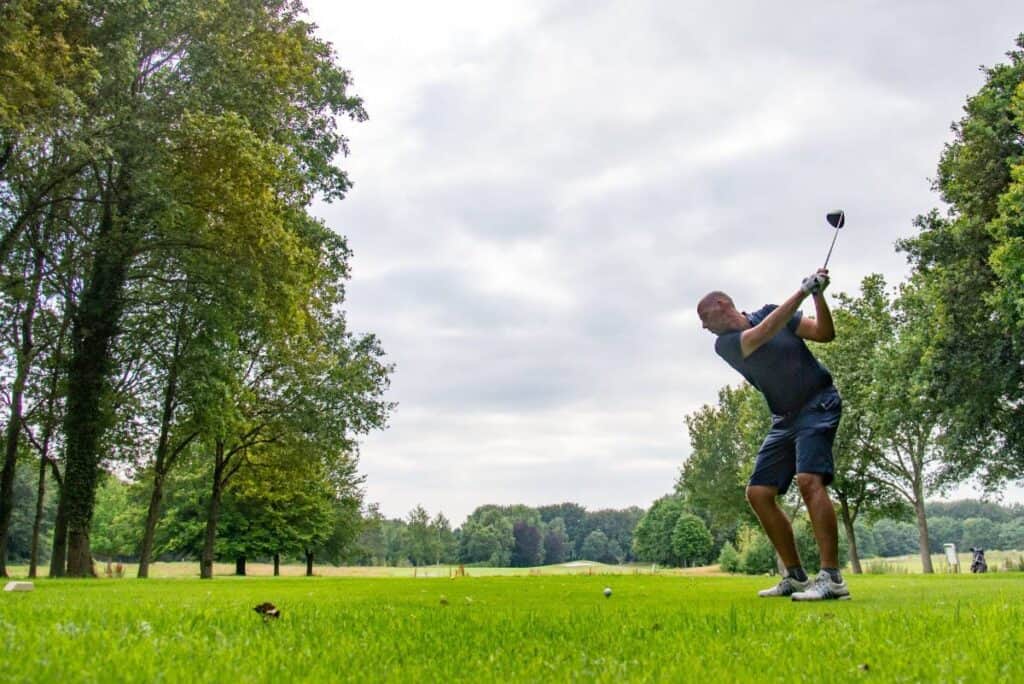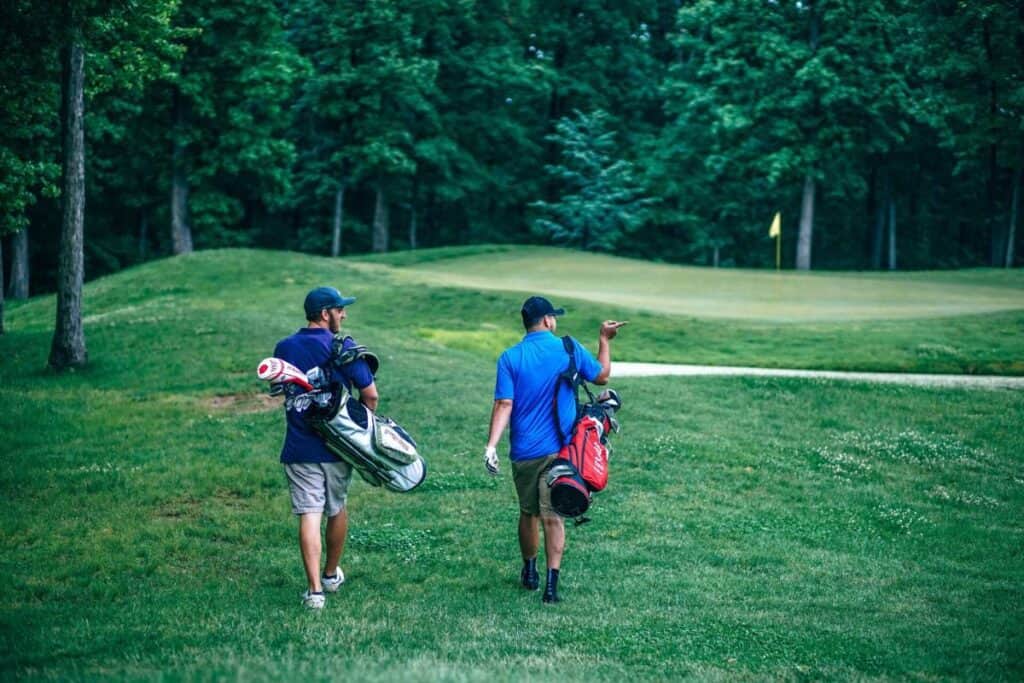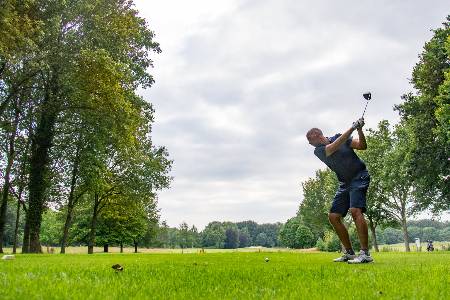
A long-held debate within sports circles has centered on whether golf is a sport. With funny-looking outfits and leisurely rides in golf carts, the naysayers are always quick to present their case that it isn’t. However, recent inclusion in the Olympics and the Oxford definition of sport says otherwise.
So, is golf a sport?
Yes, golf is a sport because it is an activity that requires skills like hand-eye coordination, one needs equipment to play, it is governed by a set of rules and it is recognized around the world as it is played in over 200 countries spanning six continents.
Per the Oxford definition, sport is defined as “an activity involving physical exertion and skill, one regulated by a set of rules or customs in which an individual or a team competes against another or others for entertainment. Similarly, Dictionary.com defines a sport as “an athletic activity requiring skill or physical prowess”.
The International Olympic Committee (IOC) recognizes that “a sport must first of all be governed by an International Federation.” Britannica adds that “the Olympic Charter indicates that to be accepted, a sport must be widely practiced by men in at least 75 countries and on four continents and by women in no fewer than 40 countries and on three continents.”
To support these three definitions of what is a sport and what isn’t, here are 10 reasons why golf is a sport:
Golf Is an Activity that Burns Calories
The game of golf requires the player to exert a lot of energy. From renting a golf cart or carrying a full set of clubs to hitting balls on the range or practicing your short game, a golfer can expect to walk a lot and burn many calories while doing so.
During play of an 18-hole round of golf, a golfer can expect to walk two to seven miles depending mostly on the number of shots hit, the length of the golf course, the distance between each hole, and how they choose to transport themselves. All of these factors will dictate how many calories they can expect to burn during a typical day on the golf course.
A golfer who chooses to carry their clubs for 18 holes can expect to burn 1,500-2,000 calories. The weight of the bag, elevation change, the golf course’s altitude above sea level, and the type of weather can all affect the number of calories one burns during a round.
Should a golfer choose to use a pushcart, the number of calories burned drops to a 1,000-1,500 calorie range. Though the golfer is still walking all 18 holes, the fact they are pushing and not lugging around their 30-pound golf bag will save a few calories as well as a little wear and tear on the body.
Hiring a caddie to carry clubs during a round again decreases the number of calories burned from 800-1,000 calories. The same cannot be said for the caddie responsible for carrying the set of clubs.
Lastly, a golfer that chooses to ride in a golf cart for their round is required to expend significantly less exertion than a golfer choosing to walk. A golfer riding in a cart however can still expect to walk two to four miles and burn 800-1,300 calories.
Golf Is an Activity that Requires Training

Say what you will about golf being a sport for retirees and beer bellies, but since the great Tiger Woods stepped on the scene in the late ’90s, golf has been a game defined by physical fitness.
Because a golfer can expect, at minimum, to walk two miles and burn 800 calories per 18-hole round, there is underlying importance that the person has the physical capacity and endurance to expend a lot of energy over four hours of activity.
A prime example comes from 2020 US Open Champion, professional golfer Bryson DeChambeau. During the offseason for the 2019-20 PGA TOUR season, Bryson completely transformed his body by gaining 30 pounds of muscle and bulk.
Here’s a glimpse into his mindset per a June 2020 interview with Men’s Health: “I want to try and get stronger because I know there’s an advantage to be gained. So I set out to do that, and I’ve been healthier and stronger ever since.”
His training regimen includes lots of protein shakes and exercises that focus on core strengthening, understanding that it can help him increase his swing speed which ultimately leads to hitting the ball further. The hard work and effort paid off as Bryson led the 2019-20 PGA TOUR season for the length of an average drive at 322.1 yards.
Golf Is an Activity that Requires Coordination
From hand-eye coordination, muscle control, and balance to strategic processing and emotional control, golf is a game that requires many coordinated efforts to master its difficult ways. Let’s dive deeper into these skills to support the argument that golf is a sport:
- Hand-Eye Coordination: Similar to baseball, golf requires the “simultaneous use of hands and eyes” using “visual spatial perception to guide [the] hands to carry out a movement.” But unlike baseball, the object being hit, i.e. the golf ball, is much smaller than a baseball and the surface area of the clubface, or the part of the golf club that makes contact with the golf ball, is also much smaller than a baseball bat. Above-average and elite professional golfers have incredible athletic ability and can manipulate the clubface in such a way to influence the golf ball’s trajectory, spin, and curvature all with the complex coordinated effort between the eyes and the hands.
- Muscle Control: Not every golf shot is hit with maximum power and force. It could be argued that hitting a shot with 75% of maximum speed is much more difficult than hitting a ball at full swing speed. Being able to judge how hard to hit a shot when a specific distance falls in between the maximum distance for two clubs (too far for one and too short for another) makes muscle control an important skill to play golf.
- Balance: To new and beginning golfers, the driving range offers an incomplete picture of what to expect during a round of golf because not every stance taken on the golf course will be perfectly flat. Uphill lies, downhill lies, sidehill lies, and wind all seek to throw a golfer off-balance during a round of golf. The twisting motion of the golf swing combined with the hand-eye coordination needed to make contact with the ball is a key skill for golfers to possess. Like martial arts and gymnastics, staying balanced and upright while moving the body takes coordination.
- Strategic Processing & Emotional Control: Coordination in golf is not just limited to physical abilities, it also includes mental and emotional coordination. The golfer must strike the perfect balance between managing emotions during the round (anger, excitement, nervousness) and staying focused on strategically managing the layout of the golf course.
Golf Is an Activity that is Really Difficult

Watching professional golfers on TV does little to express how truly difficult the game of golf can be. Like amateur golfers, professional golfers are prone to hitting really bad shots. But one thing they get very little credit for is how easy they make it look when hitting recovery shots following those errant shots.
Whether they are curving shots around, through, or under trees from thick rough or awkward stances, professional golfers do little to ease the frustration average golfers endure when attempting to hit from similar locations.
The skills required to manipulate the ball and squeeze shots through tiny spaces are akin to threading a needle and comes from hours upon hours of practice. These acquired skills to master golf’s difficult nature make another strong argument for its inclusion as a sport.
Golf Is an Activity that Requires Equipment
Like almost every other sport that comes to one’s mind (football, baseball, hockey, etc.), golf is similar in that they all require equipment to participate. If the amount of equipment needed to play was an indicator as to how much of a sport the activity is, golf would be near the top of the list.
Here is a list of the equipment one could expect to find in the possession of an avid golfer:
- Golf Bag: Golfers need something to carry all their stuff.
- Golf Clubs: The Rules of Golf limit each golf to a maximum of 14 clubs. They can be assembled in any combination of drivers, woods, hybrids, irons, wedges, and putters. If you are looking for a new challenge and a way to get better, try playing golf with fewer than 14 clubs.
- Golf Balls: Golfers need to hit something.
- Tees: These little wooden pegs are used only on the teeing ground and elevate the ball off the ground, making the ball easier to hit.
- Umbrella: Golf is an outside sport played in all of nature’s glory, including the rain.
- Towels and Brushes: These help golfers keep their equipment clean. When you’re playing golf, dirt and debris will get trapped in the grooves of the clubs and can inhibit one’s ability to strike a ball with maximum effectiveness.
- Rangefinder: Playing golf with a rangefinder can help tremendously by providing exact distances to targets like the flagstick, a fairway bunker, or the distance needed to clear a water hazard. If you see someone with a rangefinder on the course, they’re probably an avid golfer.
- Scorecard and Pencil: Not only is it necessary to record scores for handicap purposes, but the scorecard also tells the golfer the par for the course and the distance of each hole, among other things.
- Golf Shoes: Having proper footwear while playing golf can make all the difference. Many golfers where cleats to provide traction on damp grass and the makeup of the shoe provides the foot support needed for walking several miles during a round of golf.
- Club Head Covers: Easily one of the most customizable aspects of a golfer’s cache of equipment, club head covers are primarily used to protect drivers and woods from scratches and dents which can affect how the ball is hit and lessen the visual appeal of a golf club.
- Ball Markers: From coins to golf tees, golfers can use almost any object to mark the placement of the ball on the putting green when lifting it out of play. Ideally, a golfer wants to use something flat so if another ball rolls over the top of it, the marker is less likely to alter the golf ball’s direction.
- Ball Mark Repair Tools: A golf ball that lands on a putting green will leave a ball-sized divot on the green’s surface. Repairing this divot in the putting green is one primary responsibility all golfers must undertake to care for the course. If left unrepaired, ball marks can severely damage putting greens and create bouncy, unsmooth surfaces not optimal for making putts. Here is a graphic from the USGA on the proper way to repair a ball mark on a putting green:
Golf Is Regulated by a Set of Rules
The United States Golf Association (USGA) is the governing body of golf in the United States and its mission is to “promote and conserve the true spirit of the game of golf as embodied in its ancient and honorable traditions.” One way the USGA promotes and conserves the spirit of the game is through the management and application of the Rules of Golf.
The USGA Rules of Golf Hub has all the necessary materials needed for a golfer to better learn the rules of golf. Learning the rules of golf is often one of the most difficult aspects of the game but their inclusion is vital to maintaining the integrity and honor of the sport.
The Rules of Golf include 24 rules, 74 definitions, and several tournament committee procedures including how to mark a golf course for general play (painting lines throughout the course to identify the margins of water hazards and boundary areas) and how to conduct competitions.
Similar to the United States legal system, golf rules have precedent that derives from interpretations of the application of the rules. These interpretations must be weighed when determining how to proceed within a rule of golf.
For example, what should a golfer do if their ball comes to rest on an anthill, in a trash can, plugged in mud, or stuck in a tree? What happens when a dog, bird, or another golfer moves your ball, or even worse, what happens when you can’t find your ball? What happens if another golfer accuses you of cheating?
The Rules of Golf seek to mitigate every possible outcome that can occur on the course.
Becoming a Rules Official for a golf tournament isn’t easy either. The USGA hosts annual Rules of Golf educational seminars for golf industry professionals, tournament officials, and even casual golfers to learn more about the rules.
An optional 100 question test is given at the end of each multiday seminar. For those select few who perform well on the test (a score of 95 or better), they are invited to serve as Rules Officials at select USGA sanctioned tournaments.
For more information on the Rules of Golf, to watch videos, take practice rules tests or ask a rules question, be sure to visit the USGA Rules Hub.
Golf Is an Individual and Team Sport
Similar to tennis, swimming, and gymnastics, golf is multidimensional as a sport in that it can be played as a team or individual sport. One way to look at golf as an individual and team sport is through the lens of the NCAA Division I college golf model.
- Golf as a Team Sport: Per Golfweek, there are 253 ranked Division 1 NCAA college and university golf teams. College golf tournaments can feature eight to 20+ universities competing over two or three rounds of golf. Each team plays five golfers and the team score is tabulated from the four best 18-hole scores from each round.
- Golf as an Individual Sport: Compeitive golfers that compete in a college team tournament also compete to win the tournament as an individual golfer. Unlike the team tournament format where the four best of five scores per round count, an individual competitor counts every stroke in the tournament.
Of these two ways to compete, the vast majority of competitive golf is played individually. Most team formats outside of competitive high school and college golf tournaments are reserved for special tournaments between rival countries, allied golf associations, and clubs or informally between members of a golf foursome.
Golf Has Major Championships

Like all other sports, golf has major championships in which the greatest golfers around the world compete against each other for prize money. Professional golf has four major championships that are held annually.
Two of the four majors are ‘open’ professional tournaments meaning anyone can qualify to compete in the tournament. The other two championships are invitation only and competitors must meet pre-determined requirements for their eligibility to be considered.
Here is a brief introduction to each of the major tournaments:
- The Open Championship: Often called the British Open, this is golf’s first and oldest major championship. The first Open Championship was contested in 1860 and won by Willie Park, Sr. at Prestwick in South Ayrshire, Scotland. As the informal name implies, the Open Championship is contested within the borders of the British Isles. The tournament has a current rotation of 10 golf courses that play host to the tournament, including St. Andrew’s Golf Club in St. Andrew’s, Scotland which is known as the home of golf. The Royal & Ancient Golf Club acts as the host organization for this championship.
- The United States Open: The U.S. Open is the second oldest of the four golf majors. The first U.S. Open was held in 1895 at Newport Golf Club in Newport, Rhode Island, and was won by Horace Rawlins. The championship does not follow a rotation of golf courses like the Open Championship and is played throughout the continental United States. The USGA serves as the host organization for this championship.
- The PGA Championship: The PGA, or Professional Golfers Association, Championship was first held in 1916 at Siwanoy Country Club in Bronxville, New York, and was won by Jim Barnes. The PGA Championship was once a match play championship but in 1958 it was switched to its present-day stroke play format. The PGA Championship is like the U.S. Open in that it does not follow a rotation of golf courses like the Open and is held throughout the continental United States. The Professional Golfers Association of America serves as the host organization for this major championship.
- The Masters: The fourth and final golf major championship on the PGA Tour is The Masters Tournament which is held every year at the same course, Augusta National Golf Club in Augusta, Georgia. The first Masters Tournament was held in 1934 and was won by Horton Smith. The tournament’s host organization is the Augusta National Golf Club.
Golf Is Entertainment
Whether you think golf is exciting to watch or you find paint drying and grass growing to be more thrilling, the media’s treatment and coverage of golf help solidify the argument that golf is indeed a sport. If there is a professional golf tournament happening in the world, you can bet some broadcast outlet is airing coverage of the event.
One such broadcast outlet would be golf’s very own television channel, the Golf Channel. The Golf Channel was the first 24-hour single-sport station launched in the United States just over 25 years ago. Now owned by NBCUniversal, the Golf Channel is available in nine languages in 70 countries for nearly 500 million viewers.
Television is not the only media source that golf fans can utilize. There are many print publications like Golf Digest, Golfweek, and Golf Magazine that have covered the sport for many years.
Golf Is Played Throughout the World
As stipulated by the International Olympic Committee’s Olympic Charter, a sport “must be widely practiced by men in at least 75 countries and on four continents and by women in no fewer than 40 countries and on three continents.”
According to a report published in 2017 by the Royal & Ancient Golf Club, there are well over 200 countries, spanning six continents where golf is played, easily satisfying the IOC’s Olympic Charter stipulations for inclusion as a sport.
Additionally, to meet the requirement of the International Olympic Committee, golf is governed by the International Golf Federation (IGF) which is based in Switzerland. A few objectives of the IGF include:
- “Encouraging the international development of the sport of golf”
- “Promoting golf as an Olympic and Paralympic sport” and
- “Securing the enjoyment of the rights and freedoms among its competitors and members without discrimination of any kind.”
As anyone can see, these 10 reasons why golf is a sport should dispel any preconceived notion that the game of golf is not a sport. If anything, the sport’s celebration of funny-looking clothes and leisurely golf cart rides should be embraced as the eccentric and relaxed side of a game that is not only difficult to master but often seen as boring, uninteresting, or old-fashioned.
